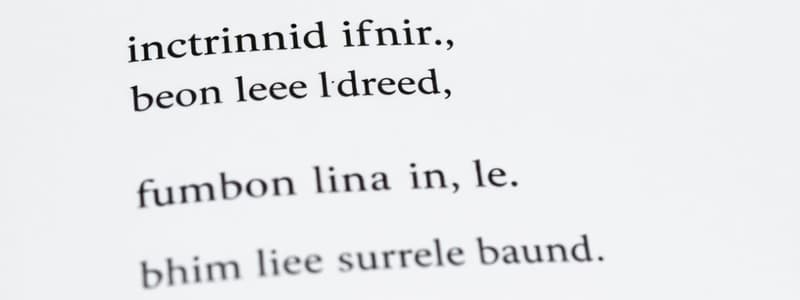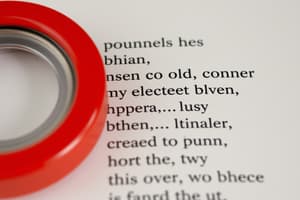Podcast
Questions and Answers
What is the primary function of a pronoun in a sentence?
What is the primary function of a pronoun in a sentence?
- To describe nouns in detail.
- To replace nouns or noun phrases. (correct)
- To indicate actions or states of being.
- To connect clauses within a sentence.
Which of the following BEST distinguishes a demonstrative adjective from a demonstrative pronoun?
Which of the following BEST distinguishes a demonstrative adjective from a demonstrative pronoun?
- Demonstrative adjectives indicate location, while demonstrative pronouns indicate time.
- Demonstrative adjectives modify verbs, while demonstrative pronouns modify nouns.
- Demonstrative adjectives are always plural, while demonstrative pronouns are always singular.
- Demonstrative adjectives are followed by nouns, while demonstrative pronouns are followed by verbs. (correct)
Which of the following pairs consists of only singular demonstrative pronouns?
Which of the following pairs consists of only singular demonstrative pronouns?
- This, That (correct)
- That, Those
- This, These
- These, Those
What is the main characteristic of an indefinite pronoun?
What is the main characteristic of an indefinite pronoun?
Why might a writer choose to use an indefinite pronoun instead of a specific noun?
Why might a writer choose to use an indefinite pronoun instead of a specific noun?
What is a crucial grammatical consideration when using indefinite pronouns like 'everybody' or 'someone'?
What is a crucial grammatical consideration when using indefinite pronouns like 'everybody' or 'someone'?
What is meant by 'gender neutrality' when discussing indefinite pronouns like 'somebody' or 'anybody'?
What is meant by 'gender neutrality' when discussing indefinite pronouns like 'somebody' or 'anybody'?
What is the primary function of a relative pronoun in sentence construction?
What is the primary function of a relative pronoun in sentence construction?
In the sentence, 'The book that I borrowed from the library is due next week,' what role does 'that' play?
In the sentence, 'The book that I borrowed from the library is due next week,' what role does 'that' play?
Which of the following BEST describes the relationship between a relative pronoun and the adjective clause it introduces?
Which of the following BEST describes the relationship between a relative pronoun and the adjective clause it introduces?
Applying which prefix to the root word 'regulate' would result in a word with doubled letters, according to the rules described?
Applying which prefix to the root word 'regulate' would result in a word with doubled letters, according to the rules described?
Which of the following words demonstrates the suffix rule where a silent 'e' is dropped before adding a suffix that begins with a vowel?
Which of the following words demonstrates the suffix rule where a silent 'e' is dropped before adding a suffix that begins with a vowel?
Which of the following pairs is an example of homographs, based on the definitions provided?
Which of the following pairs is an example of homographs, based on the definitions provided?
In which of these sentences is a comma used correctly to separate items in a list?
In which of these sentences is a comma used correctly to separate items in a list?
Which of the following is the most encompassing category of words that share similarities in sound or spelling, as described in the text?
Which of the following is the most encompassing category of words that share similarities in sound or spelling, as described in the text?
Which sentence correctly utilizes a comma after an introductory clause?
Which sentence correctly utilizes a comma after an introductory clause?
Which of the following words demonstrates doubling the final consonant when adding a suffix to a one-syllable word with a short vowel sound?
Which of the following words demonstrates doubling the final consonant when adding a suffix to a one-syllable word with a short vowel sound?
In which sentence is the comma correctly used to set off a nonessential part of the sentence?
In which sentence is the comma correctly used to set off a nonessential part of the sentence?
Which pair of words is an example of homophones?
Which pair of words is an example of homophones?
According to the rules described, which of the following prefixes would most likely require a hyphen to prevent word confusion when combined with a root word?
According to the rules described, which of the following prefixes would most likely require a hyphen to prevent word confusion when combined with a root word?
Which sentence demonstrates the correct use of a relative pronoun?
Which sentence demonstrates the correct use of a relative pronoun?
Which of the following is NOT classified as a type of intensifier?
Which of the following is NOT classified as a type of intensifier?
Identifying verbals can be challenging primarily because they:
Identifying verbals can be challenging primarily because they:
What is the fundamental distinction between a gerund and a participle?
What is the fundamental distinction between a gerund and a participle?
When an infinitive phrase acts as an adverb at the commencement of a sentence, which punctuation mark should immediately follow it?
When an infinitive phrase acts as an adverb at the commencement of a sentence, which punctuation mark should immediately follow it?
Which of the following accurately defines a root word?
Which of the following accurately defines a root word?
Prefixes are defined as word parts that are added to which part of a root word?
Prefixes are defined as word parts that are added to which part of a root word?
A 'zero relative pronoun' is characterized by:
A 'zero relative pronoun' is characterized by:
For optimal clarity in writing, where should modifiers ideally be positioned in relation to the words they modify?
For optimal clarity in writing, where should modifiers ideally be positioned in relation to the words they modify?
In formal writing contexts, the use of intensifiers is generally:
In formal writing contexts, the use of intensifiers is generally:
Flashcards
Demonstrative Pronoun
Demonstrative Pronoun
A pronoun that refers to a specific noun, noun phrase, or clause. Examples include "this", "that", "these", and "those".
Singular and Plural Demonstrative Pronouns
Singular and Plural Demonstrative Pronouns
They can be singular ("this", "that") or plural ("these", "those").
Functional Roles of Demonstrative Pronouns
Functional Roles of Demonstrative Pronouns
Demonstrative pronouns act like nouns, taking on the roles of a subject, object, or object of a preposition.
Proximity of Demonstrative Pronouns
Proximity of Demonstrative Pronouns
Signup and view all the flashcards
Demonstrative Adjectives vs. Pronouns
Demonstrative Adjectives vs. Pronouns
Signup and view all the flashcards
Pronoun
Pronoun
Signup and view all the flashcards
Pronoun Functions
Pronoun Functions
Signup and view all the flashcards
Indefinite Pronouns
Indefinite Pronouns
Signup and view all the flashcards
Indefinite Pronoun Functions
Indefinite Pronoun Functions
Signup and view all the flashcards
Relative Pronouns
Relative Pronouns
Signup and view all the flashcards
Modifier
Modifier
Signup and view all the flashcards
Adjective
Adjective
Signup and view all the flashcards
Adverb
Adverb
Signup and view all the flashcards
Relative Clause
Relative Clause
Signup and view all the flashcards
Verbal
Verbal
Signup and view all the flashcards
Gerund
Gerund
Signup and view all the flashcards
Participle
Participle
Signup and view all the flashcards
Infinitive
Infinitive
Signup and view all the flashcards
Infinitive phrase
Infinitive phrase
Signup and view all the flashcards
What is a prefix?
What is a prefix?
Signup and view all the flashcards
What does the prefix 'sub-' mean?
What does the prefix 'sub-' mean?
Signup and view all the flashcards
What is a root word?
What is a root word?
Signup and view all the flashcards
What is a suffix?
What is a suffix?
Signup and view all the flashcards
What is a homograph?
What is a homograph?
Signup and view all the flashcards
What is a homophone?
What is a homophone?
Signup and view all the flashcards
What is a homonym?
What is a homonym?
Signup and view all the flashcards
What is a comma?
What is a comma?
Signup and view all the flashcards
When is a comma used?
When is a comma used?
Signup and view all the flashcards
How is a comma used with a coordinating conjunction?
How is a comma used with a coordinating conjunction?
Signup and view all the flashcards
Study Notes
Pronouns and Demonstrative Pronouns
- Pronouns replace nouns or noun phrases.
- Demonstrative pronouns (this, that, these, those) point to specific nouns, noun phrases, or clauses.
- Demonstrative pronouns should be close to the noun/noun phrase they relate to.
- This/that are singular; these/those are plural.
- Demonstrative adjectives describe/modify nouns or pronouns (e.g., this book, that car).
- Demonstrative pronouns precede verbs, while adjectives are followed by nouns.
Indefinite Pronouns
- Indefinite pronouns refer to unspecified nouns.
- Used when a specific noun is not needed.
- Verbs must agree with the indefinite pronoun; some are singular, some plural, and some can be either.
- Be mindful of gender neutrality when using pronouns like "someone."
Relative Pronouns
- Relative pronouns connect nouns/pronouns to adjective clauses.
- Adjective clauses give more detail about the noun/pronoun.
- Common relative pronouns: who, whom, whose, which, that, whoever, whomever.
- Sometimes, the relative pronoun is omitted (zero relative).
- Relative pronouns are rarely used alone but rather used to form interrogative sentences.
Modifiers
- Modifiers in English include adjectives (modify nouns) and adverbs (modify adverbs, verbs, adjectives, sentences).
- Avoid excessive use of adjectives; use strong verbs/adverbs instead.
- Place modifiers as close as possible to the words they modify to avoid ambiguity.
Intensifiers
- Intensifiers are adverbs that modify adjectives or adverbs, increasing/decreasing intensity.
- Types include: emphasizers, amplifiers, and downtoners.
- Intensifiers are premodifiers (placed before the words they modify).
- Avoid overusing intensifiers in formal writing. Use strong adjectives/adverbs instead.
- Intensifiers can be valuable in dialogue/character narration.
Verbals
- Verbals are verbs functioning as nouns, adjectives, or adverbs.
- Three types: gerunds, participles, and infinitives.
- Gerunds are nouns ending in "-ing" (e.g., playing, eating).
- Participles are adjectives, with "present participles" ending in "-ing" and "past participles" ending in "-ed," "-d," "-t," "-en," or "-n."
- Infinitives are verbals with "to" + verb base form (e.g., to play, to sing).
Infinitive Phrases
- Infinitive phrases start with "to" + a verb.
- Infinitive phrases can function as nouns, subjects, objects, adjectives or adverbs.
- Commas are sometimes needed around infinitive phrases, especially as introductory adverbs.
Prefixes and Suffixes
- Prefixes go before root words.
- Suffixes go after root words.
- Prefixes/suffixes change word meaning/type.
- Rules for adding prefixes/suffixes may involve doubling consonants, dropping final "e", or using hyphens.
Homophones, Homographs, and Homonyms
- Homophones: sound the same but have different spellings/meanings.
- Homographs: spelled the same but have different meanings/pronunciations.
- Homonyms: same spelling and pronunciation, or both.
- Context helps decipher the correct meaning.
Commas
- Commas delineate sentence segments clearly.
- Use commas after coordinating conjunctions, introductory clauses, in lists, around nonessential phrases, for appositives, quotes, and dates.
- Separate items in a series and place them inside quotation marks in a dialogue.
Studying That Suits You
Use AI to generate personalized quizzes and flashcards to suit your learning preferences.



